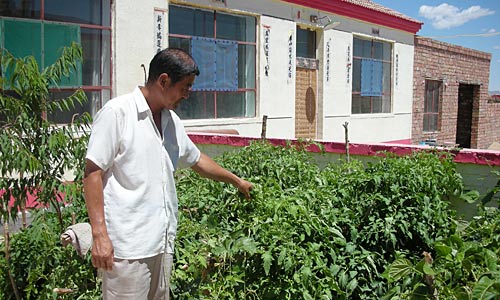|
 |
|
A NEW LIFE: Bagenna, a migrant Mongolian, checks vegetables in his new yard in Bayintala Gacha in Wulate Rear Banner of Inner Mongolia's Bayan Nur City on July 17 (YIN PUMIN) |
Meanwhile, in order to let nature fully display its self-regeneration capacity, Inner Mongolia implemented a system to forbid, suspend or rotate grazing. By the end of 2009, it applied to 52 million hectares of grasslands in the region.
The ecological migrants either moved to somewhere with better water resources and started to plant and barn feed or they resettled in urban areas, to work in the service sector, said Ji Dacai, Deputy Director of the regional agriculture and animal husbandry department.
"The government offered resettlement subsidies to those willing to be relocated, housing, 12 years of free education for children and a pension system," Ji said.
In 2005, the Agriculture and Animal Husbandry Department and the Department of Land and Resources of Inner Mongolia jointly carried out a pilot project to confirm the area of basic grasslands.
The project involved 37 banners and counties. Today, 56 million hectares of grasslands in the region have been confirmed as basic grasslands by the new Grassland Law, accounting for 63.6 percent of the total area of grasslands in Inner Mongolia. Under the law, those basic grasslands can be better protected, said Ji.
New life
In 1998, the policy of returning grazing land to grassland started to be implemented in the Ejin Horo Banner. Like many other herders, Aotegen and his family moved out of their original home and settled down on the edge of the grasslands.
"At that time, my family received 40 hectares of grassland as our own family ranch from the banner government and could get an allowance of 900 yuan ($131.77) per person a year," he said.
In 2004, under the support of the government, Aotegen started his tourism career. With an investment of 3,000 yuan ($439.24) from the government, Aotegen set up his first Mongolian yurt and earned more than 3,000 yuan in the year.
Along with income going up, Aotegen started updating equipment and expanding his business. Today, his family owns four yurts and can earn 200,000-300,000 yuan ($29,280-43,920) each year.
Subu'erga Village is a new village for ecological migrants in Ejin Horo Banner. The village was completed in 2007 and at present holds more than 180 families of migrants.
"I chose to move into the new village because we could no longer use the original grasslands to feed enough goats to make a living," said 48-year-old Liu Feiliang.
"To be honest, I felt uncomfortable rearing livestock in an enclosure at the beginning. As herders, generations of us have grazed cattle on the vast grasslands. But I gradually realized that barn feeding is more efficient," Liu said.
| 